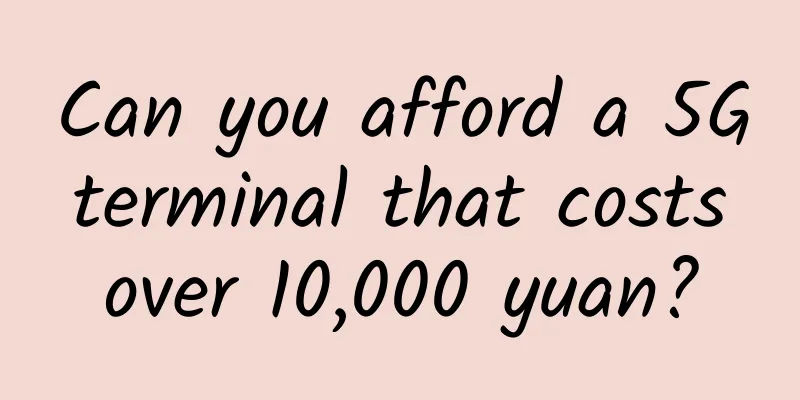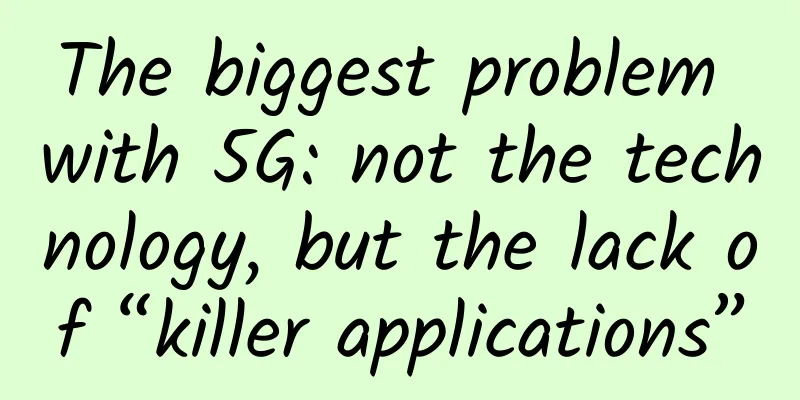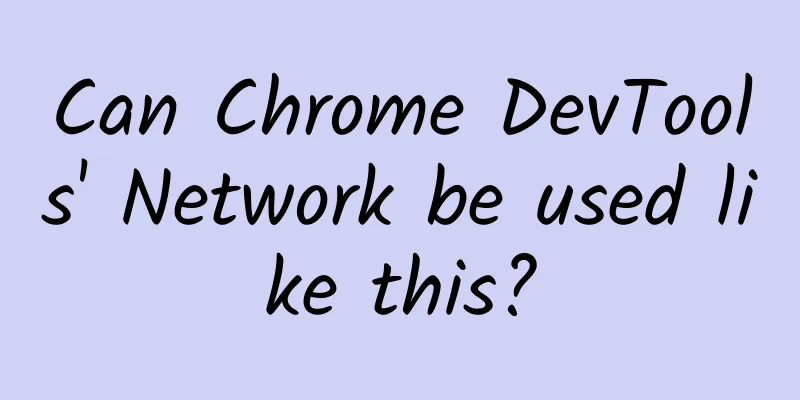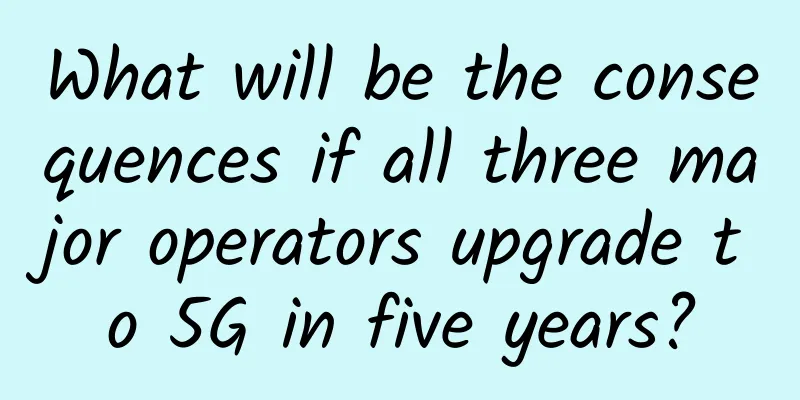5G may disappoint consumers because it has no other advantages except fast speed

|
Less than four years after the issuance of 4G licenses, the construction of 5G networks is already imminent. According to media reports, China's three major operators will invest $180 billion and plan to build the world's largest 5G network within seven years. At present, consumers' perception of 5G networks is that they are faster. From 3G to 4G, consumers are enjoying the convenience brought by technological changes. At the same time, consumers also expect that after the popularization of 5G networks, the charges will be lower and the signal coverage will be better. Based on information from all aspects, in addition to the fast speed, 5G networks may disappoint users.
Signal coverage is a problem As the fifth generation of mobile communication network, the most eye-catching advantage of 5G is its faster speed. It is reported that the theoretical transmission speed of 5G network can reach tens of Gb per second, which is hundreds of times faster than the existing 4G network. In the future, using 5G network to download an entire ultra-high-definition movie, it will take less than 1 second to complete the download. In the absence of 100M broadband, the faster 5G network is worth looking forward to. However, the 5G network still has shortcomings in signal coverage. Since 5G network technology mainly uses ultra-high frequency spectrum, it can provide higher data transmission rates, but the electromagnetic wave transmission distance in this frequency band is very short and easily blocked by obstacles. In order to achieve better signal coverage of 5G networks, operators need to build millions of small base stations and deploy them to every utility pole, every building, every house, and even every room. Careful consumers will find that as mobile Internet speeds grow rapidly, the number of mobile base stations also increases. In the 2G era, the number of base stations operated by operators was quite small. After 2G signal coverage matured, basically only 1-2 base stations were needed in a town to achieve seamless coverage. After entering the 3G era, the number of base stations operated by operators increased sharply, and there would be signal blind spots even if there were 5 base stations in a town. After the popularization of 4G networks, we will find that several villages need one base station. At present, 4G network licenses have been issued for more than three years, and many areas still have problems with 4G network coverage. It is unpredictable that 5G network signal coverage is more difficult than 4G network. According to the plan of the Ministry of Industry and Information Technology, a large-scale trial network will be carried out in 2018, and 5G network will be officially launched for commercial service in 2020. Even so, signal coverage will still be a major flaw after the commercialization of 5G network. In cities with tall buildings, 5G signals will be worse. The embarrassment of rising data charges Forget to turn off China Mobile 4G, and when you wake up, your house is gone. This joke that once circulated on the Internet reflects the fact that 4G network charges are high. Under the Ministry of Industry and Information Technology's policy of speeding up and reducing fees, mobile Internet traffic charges have been reduced, but they are not affordable. For this reason, many consumers pin their hopes on 5G to reduce charges. From the perspective of the evolution of network technology from 3G to 4G, the overall tariff is still rising. After all, the three major operators have invested huge amounts of money in the construction of 3G and 4G networks. Data shows that the three major operators, China Mobile, China Unicom and China Telecom, invested an estimated US$117 billion in 4G networks from 2013 to 2020. This is also the fundamental reason for the increase in tariffs. After all, operators are not public welfare organizations and need to make profits. The huge investment of the three major operators is reflected in the change in tariffs, which is that the entry threshold has become higher. For China Unicom, the entry threshold in the 3G era was a 66 yuan package, and the entry threshold in the 4G era was 76 yuan. Similarly, the entry thresholds of China Telecom and China Mobile have also increased. According to the investment scale of the three major operators in 5G network construction, once the 5G network is commercially available, the tariff will inevitably be higher than the 4G tariff. In the same seven years, the three major operators invested 117 billion US dollars in 4G networks and 180 billion US dollars in 5G networks, an increase of 48%. Imagine that the three major operators have invested more in 5G networks, so how could the tariffs be reduced? After all, the Ministry of Industry and Information Technology still has KPI assessments of profit indicators. In addition, the shorter update time of network technology standards is also an important reason for the higher 5G charges. In 1994, Fujian Province launched the first GSM digital mobile phone in China; in December 2008, the Ministry of Industry and Information Technology issued 3G licenses to the three major operators, and 4G licenses were issued in December 2013. It took 14 years to upgrade from 2G network to 3G network, while it took only 5 years to upgrade from 3G network to 4G network. In such a short period of time, the network technology is frequently upgraded, and the operators are bound to bear a greater burden. In order to recover costs faster, it is not difficult to understand that the charges are increased. 5G mobile phone battery life faces challenges In recent years, many consumers have complained about the battery life of smartphones. Back in the 2G era, people could easily use Nokia phones on standby for a week, and even if they were busy with phone calls every day, they could still tolerate charging every 2 or 3 days. After entering the 5G era, consumers will be disappointed by the worse battery life experience than 4G phones. In fact, as early as the 3G era, consumers have been troubled by the battery life of smartphones. Compared with 2G phones, 4G phones with larger battery capacity have a much different standby time. Among many mobile phone applications, data traffic Internet access is the most power-consuming application, without a doubt. Some industry insiders said that the faster the mobile phone Internet access speed, the more power it consumes. If this theory is true, then using a 5G mobile phone to surf the Internet may require charging once every half a day. Take Apple mobile phones for example, we can find the changes in the battery life of mobile phones under different network technology standards. The battery capacity of the iPhone 4, which first entered the domestic market, is 1470 mAh, which can last for a day without heavy use. The battery capacity of the latest generation iPhone 7 Plus is 2910 mAh, which can barely last for a day with 4G data and non-critical use. It is not difficult to find that when the battery capacity is almost doubled, the standby time does not change much, which is enough to show that the faster the Internet speed, the more power the phone consumes. With battery technology already encountering bottlenecks, 5G networks do offer faster Internet access, but the resulting problem is that battery life will be shorter. Although Huawei and Gionee have launched mobile phones with longer battery life, in the 5G era, mobile phone battery life is still a hard indicator that affects consumer experience. In short, the current perception of 5G networks for ordinary consumers is just faster Internet access. Like other technologies, 5G technology has also encountered innovation bottlenecks during its development. Therefore, apart from fast Internet access speed, 5G networks with poor signal coverage and higher rates are really nothing worth consumers looking forward to. |
<<: Four key concepts you need to know about AI
>>: The next generation of computing defined by Cisco is born
Recommend
80VPS: VPS annual payment starts from 199 yuan, dedicated server starts from 350 yuan/month, Hong Kong/US/Korea data center
Last month, the tribe shared information about 80...
Comprehensive understanding of TCP/IP knowledge system structure summary
1. TCP Knowledge System We analyze the TCP knowle...
An article to help you understand HTML5 MathML
[[347913]] HTML5 can use MathML elements in docum...
ZTE Chief Scientist Talks About the Current Status of 5G
[51CTO.com original article] The Internet of Thin...
TripodCloud: San Jose CN2 GIA line starting at $38.99/half year, optional large hard drive
TripodCloud (Yunding Network) is a low-key Chines...
Zhang Xuezhi from the Ministry of Industry and Information Technology: We will continue to support all parties in the industry to jointly promote the development of 5G applications
[[411408]] From July 13 to 15, the 2021 China Int...
To promote the building of core capabilities, Huawei proposes a top-level design framework for operators' digital transformation
Today, at the MWCS 2021 media analyst pre-communi...
5G and blockchain empower each other and accelerate the digital economy
This year, many representatives and committee mem...
The Internet of Things in the Eyes of Operators: From 0 to 300,000, and then to the stars and the sea
In the forecast of the Internet of Things with tr...
The first "government cloud" platform in our province was launched in Xinzhou
Recently, with the "Xinzhou Public Trading P...
Be careful not to be cheated. I will teach you how to buy a wireless router.
Before the full resumption of work, production an...
VXLAN technology introduction: Building a virtual Layer 2 network with a Layer 3 network
1. VXLAN Overview 1. What is VXLAN VXLAN (Virtual...
Learn how to use IPv6 to surf the Internet in five minutes
1. Introduction to IPv6 As the technical foundati...
F5 creates “applications that are aware, controllable, and adaptable” to help enterprises achieve extraordinary digital experiences
On December 16, 2020, F5 held an online press con...
5G: Retracing the path of 4G?
2 years, 350 million. This is the answer given af...









